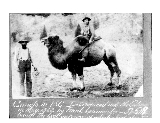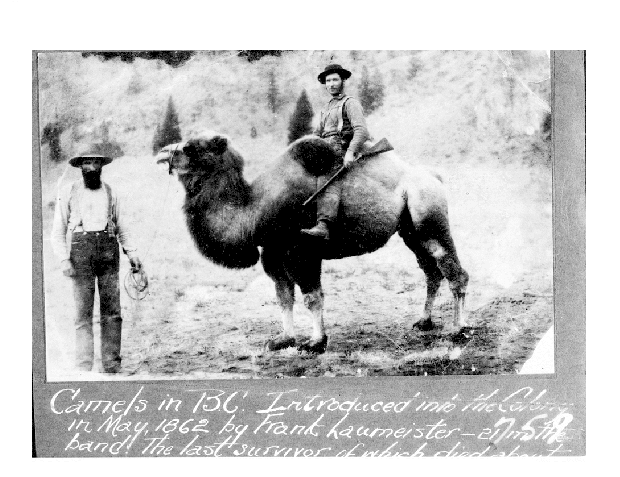
Cariboo camels
Encyclopedia

British Columbia
British Columbia is the westernmost of Canada's provinces and is known for its natural beauty, as reflected in its Latin motto, Splendor sine occasu . Its name was chosen by Queen Victoria in 1858...
. The Bactrian camels were used on the Douglas Road
Douglas Road
The Douglas Road, aka the Lillooet Trail, Harrison Trail or Lakes Route, was a goldrush-era transportation route from the British Columbia Coast to the Interior...
and the Old Cariboo Road
Old Cariboo Road
The Old Cariboo Road is a reference to the original wagon road to the Cariboo gold fields in what is now the Canadian province of British Columbia...
in 1862 and 1863 to haul freight during the Cariboo Gold Rush
Cariboo Gold Rush
The Cariboo Gold Rush was a gold rush in the Canadian province of British Columbia. Although the first gold discovery was made in 1859 at Horsefly Creek, followed by more strikes at Keithley Creek and Antler Horns lake in 1860, the actual rush did not begin until 1861, when these discoveries were...
. Although the experiment was a failure, the Cariboo camels became the stuff of legend and when other gold rush history was forgotten, the stories of the camels lived on and they are still remembered in every corner of the Cariboo
Cariboo
The Cariboo is an intermontane region of British Columbia along a plateau stretching from the Fraser Canyon to the Cariboo Mountains. The name is a reference to the woodland caribou that were once abundant in the region...
and all throughout British Columbia.
The camels are coming!
It began on March 1, 1862 with an advertisement in the Victoria Colonist that offered camels for sale with an address where interested parties could go for further information.The camels were being sold by a San Francisco merchant, Otto Esche, who may have been partly inspired by use of dromedary camels by the US Army Camel Corps. These Bactrian camels had worked in Arizona
Arizona
Arizona ; is a state located in the southwestern region of the United States. It is also part of the western United States and the mountain west. The capital and largest city is Phoenix...
for rail construction and Esche had used them as pack animals during the California Gold Rush
California Gold Rush
The California Gold Rush began on January 24, 1848, when gold was found by James W. Marshall at Sutter's Mill in Coloma, California. The first to hear confirmed information of the gold rush were the people in Oregon, the Sandwich Islands , and Latin America, who were the first to start flocking to...
.
The editor of the Colonist couldn’t resist headlining the paper with "The Camels are Coming!" and with a flamboyant journalism typical of the day added, "and after they have been disposed of, a number of trained whales will be placed on the route between Victoria
Victoria, British Columbia
Victoria is the capital city of British Columbia, Canada and is located on the southern tip of Vancouver Island off Canada's Pacific coast. The city has a population of about 78,000 within the metropolitan area of Greater Victoria, which has a population of 360,063, the 15th most populous Canadian...
and the Stikine River
Stikine River
The Stikine River is a river, historically also the Stickeen River, approximately 610 km long, in northwestern British Columbia in Canada and southeastern Alaska in the United States...
carrying freight and inside passengers a la Jonah
Jonah
Jonah is the name given in the Hebrew Bible to a prophet of the northern kingdom of Israel in about the 8th century BC, the eponymous central character in the Book of Jonah, famous for being swallowed by a fish or a whale, depending on translation...
".
On March 15, the Colonist continued the story, reporting that Lillooet
Lillooet, British Columbia
Lillooet is a community on the Fraser River in western Canada, about up the British Columbia Railway line from Vancouver. Situated at an intersection of deep gorges in the lee of the Coast Mountains, it has a dry climate- of precipitation is recorded annually at the town's weather station,...
man, John Calbreath had purchased 23 of these animals for $300 a head and was planning to use them on the Old Cariboo Road to freight goods from Lillooet to Alexandria
Alexandria, British Columbia
Alexandria or Fort Alexandria is a National Historic Site of Canada on the Fraser River in British Columbia, and was the end of the Old Cariboo Road and the Cariboo Wagon Road...
.
Calbreath was a representative of several other businessmen who were involved in this venture, Frank Laumeister, Adam Heffley and Henry Ingram. However, as the story unfolded, it was Laumeister whose name became the most associated with the Cariboo camels. Both Calbreath and Laumeister would later become involved in the Cassiar Gold Rush, owning stores and operating freighting businesses, although no camels would have any part of these ventures.
1862
The camels arrived in Victoria on April 15 on the steamship Hermann. They remained in the city until May 4 and were the subject of much local interest, as well as more headlines and editorials. One baby camel was born during their stay, and another escaped with its mother into the wilds of Vancouver IslandVancouver Island
Vancouver Island is a large island in British Columbia, Canada. It is one of several North American locations named after George Vancouver, the British Royal Navy officer who explored the Pacific Northwest coast of North America between 1791 and 1794...
and wouldn’t be seen until that fall near Cadboro Bay.
The others were loaded onto a barge
Barge
A barge is a flat-bottomed boat, built mainly for river and canal transport of heavy goods. Some barges are not self-propelled and need to be towed by tugboats or pushed by towboats...
and towed by William Moore
William Moore (steamship captain)
William Moore was a steamship captain, businessman, miner and explorer in British Columbia and Alaska. During most of British Columbia's gold rushes Moore could be found at the center of activity, either providing transportation to the miners, working claims or delivering mail and...
's Flying Dutchman to New Westminster
New Westminster, British Columbia
New Westminster is an historically important city in the Lower Mainland region of British Columbia, Canada, and is a member municipality of the Greater Vancouver Regional District. It was founded as the capital of the Colony of British Columbia ....
and on to Port Douglas
Port Douglas, British Columbia
Port Douglas, sometimes referred to simply as Douglas, is a remote community in British Columbia, Canada at the head of Harrison Lake, which is the head of river navigation from the Strait of Georgia...
. By the middle of May they were working on the Pemberton Portage on the Douglas Road.
At first, the camels seemed to be performing well. They carried twice the loads that mules did: usually 500-600 pounds, and they were good foragers. However, their soft feet were easily torn up by the harsh terrain of the Cariboo Road and boots of canvas had to be made for them.
By the end of June, the first camel train had left Lillooet for Alexandria and the papers reported the one camel was killed when it slid off a cliff into the Pavilion Creek. Soon more reports came in from the Cariboo, mostly complaints from the stagecoach
Stagecoach
A stagecoach is a type of covered wagon for passengers and goods, strongly sprung and drawn by four horses, usually four-in-hand. Widely used before the introduction of railway transport, it made regular trips between stages or stations, which were places of rest provided for stagecoach travelers...
drivers and the miners. Stage horses were terrified at the very sight of camels and even the best trained of them would bolt upon encountering the camels on the road. Furthermore the camels didn’t hesitate to eat anything, pants, shirts, hats and even bars of soap.
One report mentioned Matthew Baillie Begbie
Matthew Baillie Begbie
Sir Matthew Baillie Begbie was born on the island of Mauritius, thereafter raised and educated in the United Kingdom...
's experience with the camel train and how his mount dashed off into the wilderness with the helpless judge clinging to the saddle. He would despise camels for the rest of his life.
By October, the Colonist reported that a dozen camels had survived their first season and were wintering at Quesnel Forks.
1863
In May 1863, the camels were back at Lillooet, but after creating more headlines and occasioning more threats of legal action from outraged and exasperated stage drivers, Frank Laumeister retired the camel train for good. What became of the remaining camels has always been a subject of much debate and apocryphal stories. Several were taken in at ranches, either as exotic pets or as working stock, while another was mistaken for a grizzly bear and shot by miner, John Morris, who would forever be known as "Grizzly" Morris. The camel didn’t go to waste but ended up on the menu at a hotel near Beaver Lake as a dinner special called "Grizzly's Bear".Unconfirmed camel sightings were reported all over the Cariboo and Central British Columbia for decades.
Last known survivor
The last known surviving camel was known as "The Lady" and lived at a ranch in Grand Prairie, British Columbia, now WestwoldWestwold, British Columbia
Westwold is an unincorporated settlement in the Interior of British Columbia. A small farming and logging community, it is located between Kamloops and Vernon on Highway 97. The original name for the settlement was "Grand Prairie". Glacial tills near the townsite of Westwold have provided...
. She died sometime between 1896 and 1905. The Lady is the subject of the only picture ever found of the Cariboo camels (shown above). She is shown with W.H. Smith.
Further reading
- Pioneer Days in British Columbia Volume Two Art Downs and Bruce Ramsey ISBN 0-9690546-2-9
- Three Caravans to Yuma : The Untold Story of Bactrian Camels in Western America Harlan Davey Fowler ISBN 0-8706213-1-9

